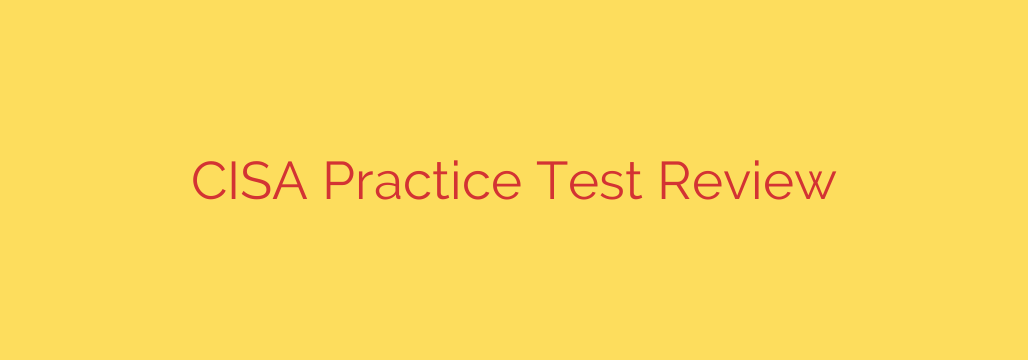
How to Pass the CISA Exam: The Ultimate Guide to Using Practice Tests
The Certified Information Systems Auditor (CISA) certification is a globally recognized standard of excellence for professionals in IT audit, control, and security. Earning your CISA credential demonstrates your expertise and can unlock significant career opportunities. However, the exam is notoriously challenging, requiring a deep understanding of broad and complex domains.
While study guides and courses are essential, one of the most powerful tools in your preparation arsenal is the CISA practice test. A high-quality practice exam does more than just quiz you—it builds the skills and confidence needed to succeed on exam day. This guide will walk you through how to choose the right practice tests and use them strategically to maximize your chances of passing.
Why CISA Practice Tests Are a Non-Negotiable Part of Your Study Plan
Simply reading the CISA Review Manual isn’t enough. The exam tests your ability to apply knowledge to real-world scenarios. This is where practice tests become critical.
- Identify Your Weaknesses: You might feel confident about a certain domain, but a practice test can reveal specific knowledge gaps you didn’t know you had. Targeting these weak areas is the most efficient way to study.
- Master the ISACA Mindset: CISA questions are often tricky, with multiple answers that seem plausible. Practice tests train you to think like an auditor and select the best possible answer according to ISACA’s framework.
- Build Mental Stamina: The CISA exam is a 4-hour, 150-question marathon. Simulating the real exam environment with timed practice tests builds the mental endurance needed to stay focused and avoid decision fatigue.
- Reduce Exam Day Anxiety: Walking into the testing center with a clear idea of what to expect—from the question format to the time pressure—can significantly boost your confidence and reduce performance-killing stress.
What Defines a High-Quality CISA Practice Test?
Not all practice tests are created equal. Investing your time in a subpar resource can be worse than doing nothing at all, as it may teach you the wrong information or create a false sense of security. Look for these key features:
- Realistic and Challenging Questions: The questions should mirror the style, format, and difficulty of the actual CISA exam. They must go beyond simple definitions and present complex scenarios that require critical thinking.
- Detailed Answer Explanations: This is the most important feature. A great practice test explains not only why the correct answer is right but also why the other options are wrong. This is where true learning happens.
- Coverage of All CISA Domains: Ensure the test bank provides balanced coverage of the latest CISA job practice areas:
- Information System Auditing Process
- Governance and Management of IT
- Information Systems Acquisition, Development, and Implementation
- Information Systems Operations and Business Resilience
- Protection of Information Assets
- Performance Analytics: The ability to track your scores by domain is invaluable. This data allows you to pinpoint your weakest domains and adjust your study plan accordingly.
- Avoid “Brain Dumps”: Stay far away from materials that claim to have the “exact” questions from the exam. These are unauthorized, unethical, and ineffective for long-term learning. Using them can result in having your certification revoked.
A Strategic Approach: How to Use Practice Tests for Maximum Impact
Buying a good practice test is the first step; using it effectively is the second. Follow this proven strategy for success.
Establish a Baseline: Before you dive deep into studying, take a full-length practice test. Don’t worry about the score. The goal is to get a raw assessment of your current knowledge and identify your weakest domains from the start.
Targeted Study Sessions: Use the results from your baseline test to guide your studies. If you scored poorly in Domain 3, for example, dedicate your focus there. Read the relevant chapters in the CISA Review Manual and other study guides.
Simulate Exam Conditions: When taking full practice exams, treat them like the real thing. Find a quiet space, set a timer for four hours, and do not use any study aids. This discipline is crucial for preparing for the actual test environment.
Review, Review, Review: The most critical step is the post-test review. Allocate as much time to reviewing your results as you did to taking the test. For every single question—whether you got it right or wrong—make sure you focus on understanding the “why” behind each answer. If you guessed correctly, find out why it was the right choice. If you were wrong, dig into the explanation until you fully grasp the concept.
Rinse and Repeat: Continue this cycle of testing, reviewing, and targeted studying. As your scores improve, you’ll build the knowledge and confidence you need. In the final two weeks before your exam, focus on taking full-length timed tests to perfect your pacing and solidify your understanding.
By integrating high-quality practice tests into a structured study plan, you move beyond rote memorization and develop the analytical skills required of a Certified Information Systems Auditor. This strategic approach will not only help you pass the exam but will also build a stronger foundation for your career in IT audit and security.
Source: https://www.helpnetsecurity.com/2025/08/01/review-cisa-certified-information-systems-auditor-practice-tests/








